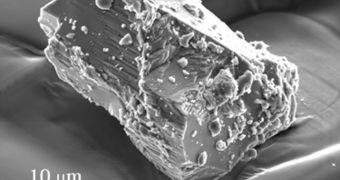A collaboration of researchers from the Okayama University and the Japan Aerospace Exploration Agency (JAXA) reports that constant collisions and bombardments by particles varying in size are responsible for making planets and space rocks grow.
The new research paper, published in the latest issue of the esteemed journal Proceedings of the National Academy of Sciences (PNAS), is the first to detail studies conducted on materials recovered from an asteroid flowing freely in outer space.
What scientists discovered was that space bodies are constantly impacted by various objects, ranging from nanoscale particles to asteroids tens of kilometers in diameter. This conclusion was reached after analyzing chondritic samples brought back from asteroid 25143 Itokawa.
These tiny fragments of the space rock were recovered by the Hayabusa sample-return mission, which parachuted them in the Australian Outback in June 2010. Only a few microscopic pieces of rock were found in the sample chamber, but they were enough for the research team.
Analyzing asteroids and meteorite is a great way to figure out what happened during the earliest days of the solar system, especially when it comes to figuring out how planets were put together.
The OU/JAXA team used an imaging technique called scanning electron microscopy to study the samples Hayabusa returned home. They discovered a number of tiny craters on the rocks' surface. These craters were between 100 and 200 nanometers in diameter.
“Impact appears to be an important process shaping the exteriors of not only large planetary bodies, such as the Moon, but also low-gravity bodies such as asteroids,” explains UO professor and study team leader, Eizo Nakamura.
The Japanese group suggests that multiple phenomena – including disaggregation, cratering, melting, adhesion, agglutination, and implantation/sputtering - are responsible for shaping up the surface of asteroids. It's possible that similar processes occurred as the planets were developing as well.
A close look at the samples also revealed the existence of a type of tectosilicate mineral that can only form when an object is cooling from a temperature of more than 860 degrees Celsius (1,580ºF). But 25143 Itokawa is only 300 meters in diameter, meaning its core cannot produce these temperatures.
The group therefore concluded that the object was originally part of a much larger asteroid. Experts also found large numbers of glassy and iron particles on the surface of the Hayabusa samples.
“We suggest that the chemistry and textures of Itokawa’s surface reflect long-term bombardment of equilibrated chondritic material, at scales of 10−9 to 104 meters,” the team concludes in the PNAS paper.

 14 DAY TRIAL //
14 DAY TRIAL //